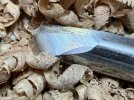Since getting started in woodturning two years ago, I have done a little experimenting with various grinds for my bowl gouges. I settled on a 50-degree, fingernail grind, as per the Wolverine settings in the Carter and Son Tools sharpening guide. I have two 60-degree, U-shaped profile, bottom feeder gouges too. I tried the very popular 40/40 grind; however, I never saw an advantage of that grind over a 50-degree fingernail grind, except for shear scraping. Kent Weakley, from Turn-a-Wood Bowl, on YouTube, swears by his Ellsworth ground bowl gouges. He grinds them to 55-degrees with sweptback wings. Klingspor sells an Ellsworth grinding jig, so I bought one two days ago.
After making an oak block that was added to the Wolverine extension arm, the getting the right grind angle took about five minutes. After that, I turned the gouge upside down and ground the wings down a little. From there, it was just creating the right profile on an 180 grit CBN wheel, and then finishing it off on a 600 grit CBN wheel. I understand why Kent uses this grind almost exclusively. For roughing the outside of a bowl, it can remove a lot of wood in a hurry. The long 58-degree (60-degrees is the traditional Ellsworth angle) makes riding the bevel easy. The long, razor sharp wings are much better at shear scraping than my 50-degree, fingernail grind, gouges. One of the places where the Ellsworth grind really shines is truing up the bottom of bowl blanks. Fingernail grind gouges can true up a blank, but the Ellsworth grind is so much better, faster, and more accurate. If that is all that this gouge could do, I'd still have on the tool rack.
Hollowing the interior of bowls or plates did not present any significant problems for the Ellsworth grind gouge. It is especially good on the bottoms, especially on bowls where the flow from the side walls is not interrupted by a relatively flat bottom. On traditional bowls, you this gouge can go from the rim to the very bottom of the bowl in one pass. On bowls or plates with nearly flat bottoms, the transition from the wall to the bottom can present a problem for any gouge, especially one with long, sweptback wings. I did have a minor catch on a bowl with a nearly flat bottom while trying to cut the transition. I have had similar problems with my bottom feeder gouges too. Sometimes the best way to deal with this has been to break out a negative rake scraper to clean up the transition.
So, is it time to retire my 50-degree fingernail gouges? Not by a long shot! These gouges make more precise push cuts and were used for the final cuts on both the outside and inside the bowls. I could have gotten away with just using the Ellsworth gouge on the outside, but the less aggressive fingernail gouge was necessary to get the best finish on the inside. Once I acquire more skill with the Ellsworth gouges, there is no reason why they should not be able to produce an acceptable final cut on the inside of bowls, boxes, and plates.
The photo shows the gouge as tested before cleaning up the final grind.
After making an oak block that was added to the Wolverine extension arm, the getting the right grind angle took about five minutes. After that, I turned the gouge upside down and ground the wings down a little. From there, it was just creating the right profile on an 180 grit CBN wheel, and then finishing it off on a 600 grit CBN wheel. I understand why Kent uses this grind almost exclusively. For roughing the outside of a bowl, it can remove a lot of wood in a hurry. The long 58-degree (60-degrees is the traditional Ellsworth angle) makes riding the bevel easy. The long, razor sharp wings are much better at shear scraping than my 50-degree, fingernail grind, gouges. One of the places where the Ellsworth grind really shines is truing up the bottom of bowl blanks. Fingernail grind gouges can true up a blank, but the Ellsworth grind is so much better, faster, and more accurate. If that is all that this gouge could do, I'd still have on the tool rack.
Hollowing the interior of bowls or plates did not present any significant problems for the Ellsworth grind gouge. It is especially good on the bottoms, especially on bowls where the flow from the side walls is not interrupted by a relatively flat bottom. On traditional bowls, you this gouge can go from the rim to the very bottom of the bowl in one pass. On bowls or plates with nearly flat bottoms, the transition from the wall to the bottom can present a problem for any gouge, especially one with long, sweptback wings. I did have a minor catch on a bowl with a nearly flat bottom while trying to cut the transition. I have had similar problems with my bottom feeder gouges too. Sometimes the best way to deal with this has been to break out a negative rake scraper to clean up the transition.
So, is it time to retire my 50-degree fingernail gouges? Not by a long shot! These gouges make more precise push cuts and were used for the final cuts on both the outside and inside the bowls. I could have gotten away with just using the Ellsworth gouge on the outside, but the less aggressive fingernail gouge was necessary to get the best finish on the inside. Once I acquire more skill with the Ellsworth gouges, there is no reason why they should not be able to produce an acceptable final cut on the inside of bowls, boxes, and plates.
The photo shows the gouge as tested before cleaning up the final grind.
Attachments
Last edited:

